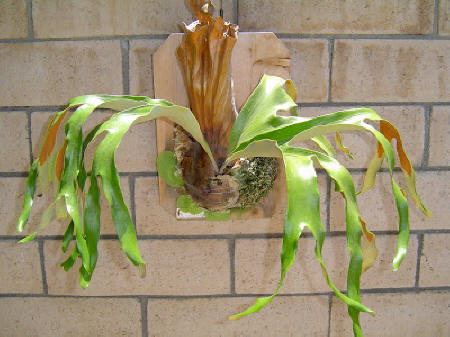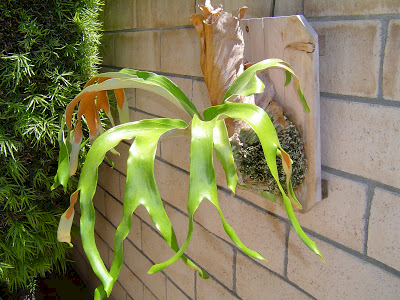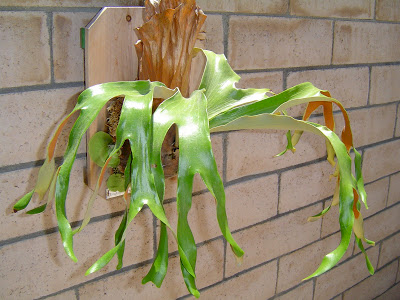|
Platycerium African
Oddity hybrid |
|
The Platycerium African Oddity is from Charles Alfords garden in Florida. He feels it is a cross of P. alcicorne but is hesitant to name the other parent. Tom Gauchi in Huntington Beach thinks it is crossed with P. quadridichotomum. This author suspects a P. andinum trait. Both are closely related and have similar traits in the fertile fronds. The argument for P. andinum is well founded in several areas. First the shield fronds are tall and narrow like P. andinum. Second the volunteer pups are appearing beside the bud and in time may form a ring basket. Third, the fertile fronds are wide and waxy, hang down. The spore patches are in the center of the fertile frond and do not extend to the tip of the frond. The argument for the P. quadridichotomum is in the fertile fronds. They appear to want to roll up on the edges to protect water stores. They are not rippled like the quad but they fork like a P. quadridichotomum. The shield fronds of P. quadridichotomum are basket like and wide at the top with small to moderate lobes. What I don't see is P. alcicorne traits. P. alcicorne has two forms. The African form which is pail green with smooth shield fronds and narrow erect fertile fronds. The Madagascar form of P. alcicorne is a dark green with narrow fertile fronds forking many times and spore patches at the tips. The Madagascar form also shows rippled shield fronds similar to the P. madagascaiense. None of these traits are seen in Tom Gauchi's photos above. The reader must realize that many hybrids are a result of accidental mixing of spore when similar plants are grown in close proximity. Even when spore from two species are intentionally crossed, it is always possible for a spore from an unintended species to contaminate the intended cross. After repeated attempts and proof that their progeny have the same traits, then we can agree as to the parentage and define it as a new hybrid and not just a sport or cultivar of a species. This can take a long time with slow growing platyceriums and experienced growers are hesitant to jump the gun and name a hybrid. So when we discuss hybrids, we need to consider all the variables. Soon we will have more definite DNA studies. Until DNA testing is more readily available, and established parent base lines defined, we must look at and compare traits from other species and deduct a logical inference to the actual parentage and these are considered individual plants and not necessarily a hybrids.
|


